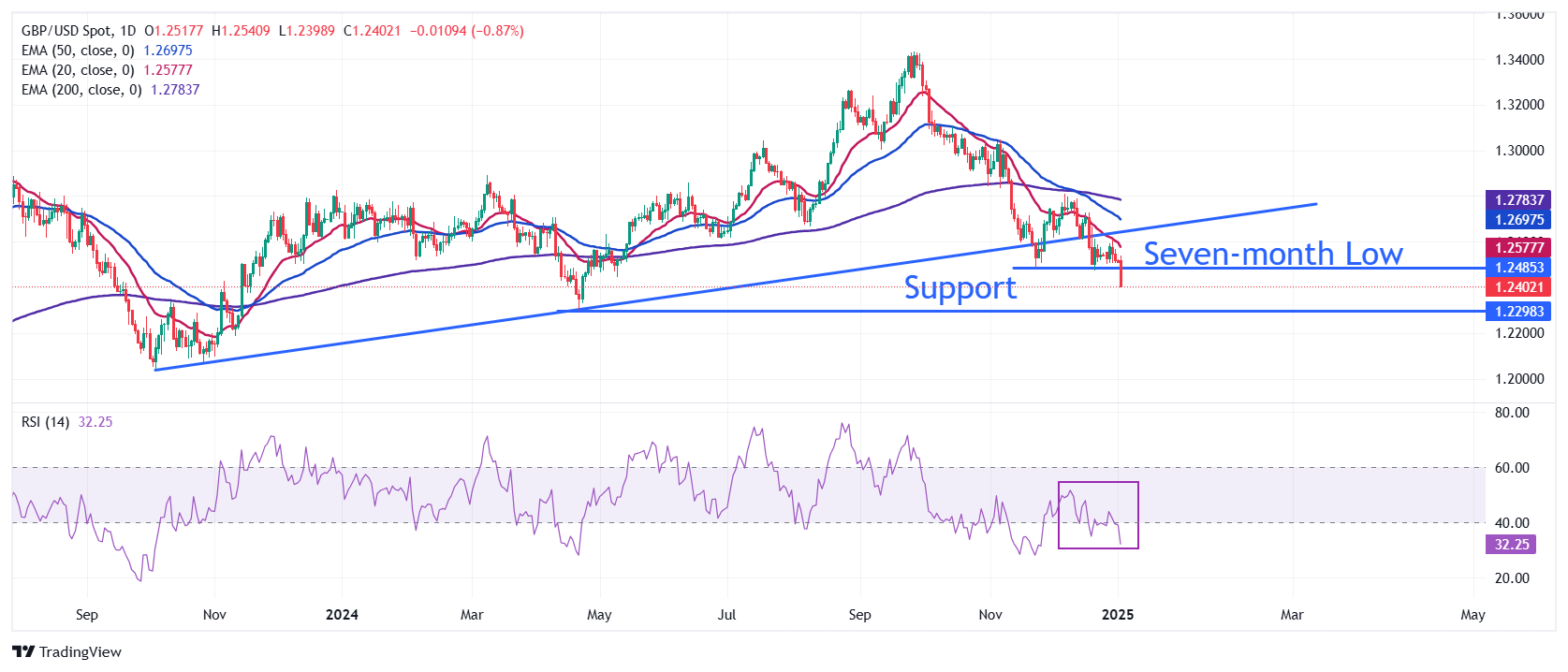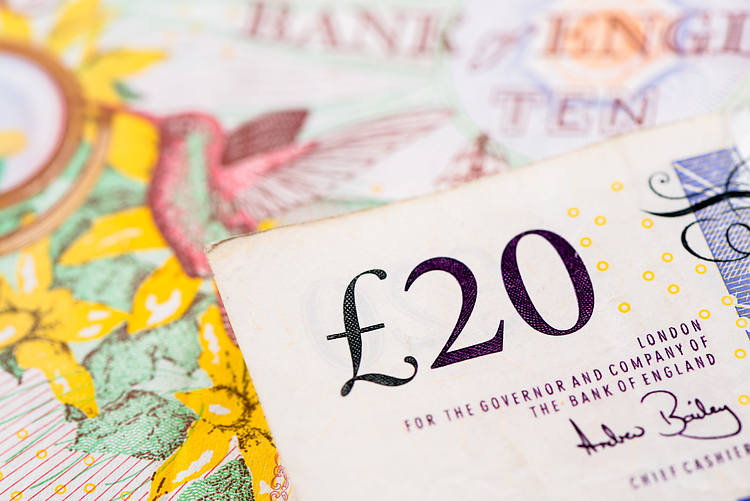Pound Sterling dives against US Dollar as US Jobless Claims dip
- The Pound Sterling plummets against the US Dollar as the Fed is expected to reduce interest rates less than previously anticipated this year.
- The British currency trades weakly across the board on weak UK Manufacturing PMI data for December.
- Investors await an array of US labor market data on Thursday for fresh Fed policy guidance.
The Pound Sterling (GBP) plunges to near 1.2400 against the US Dollar (USD) at the start of the year, the lowest level seen in more than eight months. The GBP/USD pair faces an intense sell-off as the US Dollar Index (DXY) refreshes a more-than-two-year high at around 108.90.
The greenback strengthens as the United States (US) Initial Jobless Claims for the week ending December 27 have come in lower than projected. The Department of Labour reported that individuals claiming jobless benefits for the first time were 211K, lower than estimates of 222K and the former release of 220K, upwardly revised from 219K. A lower number of individuals claiming jobless benefits indicates an improvement in the labor demand.
Apart from that, the US Dollar has benefitted from investors' expecting incoming policies from President-elect Donald Trump to boost economic growth and inflationary pressures in the US economy. This scenario will compel the Federal Reserve (Fed) to slow the pace of rate cuts, which will be favorable for the US Dollar and US Treasury yields.
Meanwhile, Fed officials have already recommended fewer interest rate cuts this year. However, Fed Chair Jerome Powell refrains from predicting the likely impact of Trump’s policies, such as immigration controls, higher import tariffs, and lower taxes, on the economy.
The latest dot plot at the Fed's Summary of Economic Projections showed that policymakers collectively see Federal Fund rates heading to 3.9% by the end of 2025, higher than the 3.4% forecasted in September.
Going forward, investors will pay close attention to a slew of US labor market-related economic indicators, which will be released next week. Signs of improving labor demand would further weigh on Fed rate cut prospects, while weak numbers would boost them.
But before that, investors will focus on the ISM Manufacturing Purchasing Managers Index (PMI) data for December, which is scheduled for Friday. The Manufacturing PMI is expected to come in at 48.3, slightly lower than the 48.4 in November.
Daily digest market movers: Pound Sterling tumbles as UK Manufacturing PMI contracts sharply
- The Pound Sterling weakens against its major peers on Thursday as the final estimate for S&P Global/CIPS Manufacturing PMI has come in weaker than the preliminary reading. The Manufacturing PMI contracted to 47.0, faster than the flash reading of 47.3. The PMI report reported that the downturn was widespread in nature, with similarly sharp rates of decline across the consumer, intermediate, and investment goods industries.
- Rob Dobson, Director at S&P Global Market Intelligence said, "Business sentiment is now at its lowest for two years, as the new Government's rhetoric and announced policy changes dampen confidence and raise costs at UK factories and their clients alike. SMEs are being especially hard hit during the latest downturn."
- Additionally, growing expectations that the Bank of England (BoE) will follow a less gradual rate-cut approach this year have also weighed on the British currency.
- The BoE reduced its key borrowing rates by 50 basis points (bps) to 4.75% in 2024. BoE’s policy-easing pace was slow compared to its European and North American peers as inflation in the United Kingdom (UK) service sector remained highly stubborn due to sticky wage growth.
- However, a slightly faster rate-cut pace is expected this year, as a slowdown in labor demand would tame price pressures. In a note this week, analysts at Goldman Sachs said that the BoE will cut interest rates each quarter through the year. This indicates that the BoE policy rate will decline to 3.75% by the year-end.
British Pound PRICE Today
The table below shows the percentage change of British Pound (GBP) against listed major currencies today. British Pound was the strongest against the Euro.
| USD | EUR | GBP | JPY | CAD | AUD | NZD | CHF | |
|---|---|---|---|---|---|---|---|---|
| USD | 0.46% | 0.95% | -0.25% | 0.31% | -0.36% | -0.19% | 0.32% | |
| EUR | -0.46% | 0.42% | -0.63% | -0.17% | -0.78% | -0.67% | -0.14% | |
| GBP | -0.95% | -0.42% | -1.09% | -0.63% | -1.30% | -1.12% | -0.66% | |
| JPY | 0.25% | 0.63% | 1.09% | 0.49% | -0.18% | -0.06% | 0.45% | |
| CAD | -0.31% | 0.17% | 0.63% | -0.49% | -0.68% | -0.53% | -0.01% | |
| AUD | 0.36% | 0.78% | 1.30% | 0.18% | 0.68% | 0.10% | 0.47% | |
| NZD | 0.19% | 0.67% | 1.12% | 0.06% | 0.53% | -0.10% | 0.57% | |
| CHF | -0.32% | 0.14% | 0.66% | -0.45% | 0.00% | -0.47% | -0.57% |
The heat map shows percentage changes of major currencies against each other. The base currency is picked from the left column, while the quote currency is picked from the top row. For example, if you pick the British Pound from the left column and move along the horizontal line to the US Dollar, the percentage change displayed in the box will represent GBP (base)/USD (quote).
Technical Analysis: Pound Sterling slides to near 1.2400

The Pound Sterling plunges to near 1.2400 against the US Dollar on Thursday. The outlook of the GBP/USD pair was already vulnerable as it trades below the upward-sloping trendline around 1.2600, which is plotted from the October 2023 low of 1.2035.
All short-to-long-term Exponential Moving Averages (EMAs) are sloping down, suggesting a strong bearish trend in the long run.
The 14-day Relative Strength Index (RSI) oscillates below 40.00, signaling that strong downside momentum.
Looking down, if the pair breaks below the immediate support of 1.2485, it is expected to find a cushion near the April 22 low at around 1.2300. On the upside, the December 17 high at 1.2730 will act as key resistance.
Economic Indicator
Initial Jobless Claims
The Initial Jobless Claims released by the US Department of Labor is a measure of the number of people filing first-time claims for state unemployment insurance. A larger-than-expected number indicates weakness in the US labor market, reflects negatively on the US economy, and is negative for the US Dollar (USD). On the other hand, a decreasing number should be taken as bullish for the USD.
Read more.Last release: Thu Jan 02, 2025 13:30
Frequency: Weekly
Actual: 211K
Consensus: 222K
Previous: 219K
Source: US Department of Labor
Every Thursday, the US Department of Labor publishes the number of previous week’s initial claims for unemployment benefits in the US. Since this reading could be highly volatile, investors may pay closer attention to the four-week average. A downtrend is seen as a sign of an improving labour market and could have a positive impact on the USD’s performance against its rivals and vice versa.
Forex News
Keep up with the financial markets, know what's happening and what is affecting the markets with our latest market updates. Analyze market movers, trends and build your trading strategies accordingly.
